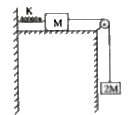Two equal masses are attached to the two ends of a spring of spring constant k. The masses are pulled out symmetrically to stretch the spring by a length x over its natural length. The work done by the spring one each mass isSolution in Tamil
12kx2
−12kx2
14kx2
−14kx2
The correct Answer is:D
Step by step video, text & image solution for Two equal masses are attached to the two ends of a spring of spring constant k. The masses are pulled out symmetrically to stretch the spring by a length x over its natural length. The work done by the spring one each mass is by Physics experts to help you in doubts & scoring excellent marks in Class 11 exams.
Topper's Solved these Questions
- BOOK - HC VERMACHAPTER - WORK AND ENERGYEXERCISE - Objective -29videos
WORK AND ENERGY
- BOOK - HC VERMACHAPTER - WORK AND ENERGYEXERCISE - Exercises64videos
WORK AND ENERGY
- BOOK - HC VERMACHAPTER - WORK AND ENERGYEXERCISE - Question for Short Answer17videos
WORK AND ENERGY
- BOOK - HC VERMACHAPTER - WAVE MOTION AND WAVES ON A STRINGEXERCISE - Exercises57videos
WAVE MOTION AND WAVES ON A STRING
Similar Questions
A heavy stone is thrown from a cliff of height h with a speed v. The stone will hit the ground with maximum speed if it is thrown
04:00View SolutionThe mass of a cyclist together with the bicycle is 90 kg. Calculate the work done by cyclist if the speed increases from 6km/h to 12 km/h.
03:45View SolutionWhen you lift a box from the floor and put it one an almirah the ptotential energy of the box increases, but thre is no change in its kinetic energy. Is it a violation of consevation of energy?
01:11View SolutionA wave pulse passing on a string with speed of 40cms−1 in the negative x direction has its maximum at x=0 at t=0. Where will this maximum be located at t=5s?
01:48View SolutionTwo equal masses are attached to the two end of a spring of force constant k the masses are pulled out symmetrically to stretch the spring by a length 2x_(0) over its natural length. Find the work done by the spring on each mass.
06:32View Solutionspring of force constant k clamped rigidly at onoe end and a mass m attached to its free end. A force F applied at the free end stretches the spring. Figure shows the same spring with both ends free and attached to a mass m at either end. Each end of the spring in figure is stretched by the same force F.
(a) What is the maximum extension of the spring in the two cases ?
(b) If the mass in figure and the two masses in figure are released free, what is the period of oscillation in each case?
 03:33View Solution
03:33View SolutionA block of mass 'm' is attached to a spring in natural length of spring constant 'k'. The other end A of the spring is moved with a constat velocity v away from the block . Find the maximum extension in the spring.
 03:20View Solution
03:20View SolutionWhen a mass M is attached to the spring of force constant k , then the spring stretches by . If the mass oscillates with amplitude l , what will be maximum potential energy stored in the spring
View SolutionA body of mass 12 kg is suspended by a coil spring of natural length 50 cm and force constant 2.0×10Nm−1. What is the stretched length of the spring ? If the body is pulled down further stretching the spring to a length of 59 cm and then released, what is the frequency of oscillation of the suspended mass ? (Neglect the mass of the spring).
03:23View SolutionTwo masses m and 2m are attached to two ends of an ideal spring as shown in figure. When thye spring is in the compressed state, the energy of the spring is 60 J, if the spring is released, then at its natural length
04:54View Solutionस्प्रिंग नियतांक k के एक स्प्रिंग के दोनों सिरों से दो समान द्रव्यमान जुड़े हुए है दोनो दव्यमानों को बराबर दूरी खीचकर स्प्रिंग को इसकी मूल लंबाई से कबई तक खीचकर रखा गया है। खीचने के दौरान स्प्रिंग के द्वारा प्रत्येक द्रव्यमान पर किया गया कार्य है
02:49View SolutionAn ideal spring having force constant k is suspended from the rigid support and a block of mass M is attached to its lowe end. The mass is released from the natural length of the spring. Then the maximum exiension in the spring is
View SolutionFigure a) shows a spring of force constant k clamped rigidly at once end and a mass m attached to its free end. A force F applied at the free end stretches the spring. Figure b) shows the same spring with both ends free and attached to a mass m at either end. Each end of the spring in figure is stretched by the same force F.
(a) What is the maximum extension of the spring in the two cases ?
(b) If the mass in figure and the two masses in figure are released free, what is the period of oscillation in each case?
 01:51View Solution
01:51View Solutionस्प्रिंग नियतांक K की एक स्प्रिंग पर m द्रव्यमान लटकाया गया है। अब स्प्रिंग को दो बराबर भागों में काटकर किसी एक पर ही द्रव्यमान लटकाया जाता है , तो नया स्प्रिंग नियतांक होगा
03:08View SolutionFigure 14.26 (a) shows a spring of force constant k clamped rigidly at one end and a mass m attached to its free end. A force F applied at the free end stretches the spring. Figure 14.26 (b) shows the same spring with both ends free and attached to a mass m at either end. Each end of the spring in Fig. 14.26(b) is stretched by the same force F.

What is the maximum extension of the spring in the two cases ?04:29View SolutionTwo blocks, of masses M and 2M are connected to a light spring of spring constant K that has one end fixed, a shown if fig. The blocks are released from the spring at its natural length codition.
 02:42View Solution
02:42View Solution

